Lifestyle
Tanning Bed Eye Safety: Protect Your Vision
Tanning bed eye safety is crucial—discover how to protect your vision and avoid serious risks that could impact your sight.

To protect your vision while using tanning beds, always wear certified UV-blocking goggles. The UV rays can be up to 100 times stronger than natural sunlight, leading to serious issues like cataracts and macular degeneration. Just closing your eyes isn't enough—UV rays can penetrate and cause lasting harm. Choose goggles that fit snugly and offer 99-100% UV protection. Limit your tanning time to decrease the risk of exposure, and be alert to symptoms like blurred vision or redness. Keeping your eyes safe is essential, and there's more to discover about maintaining your eye health during tanning sessions.
Key Takeaways
- Always wear certified UV-blocking goggles during tanning sessions to shield your eyes from harmful UV radiation.
- Limit your tanning time to reduce the risk of overexposure and protect your vision health.
- Regular eye check-ups are essential for monitoring eye health and detecting UV-related damage early.
- Educate yourself and others about the dangers of UV exposure and safe tanning practices, including using protective eyewear.
Risks of UV Radiation
The intense UV radiation from tanning beds poses serious risks to your eye health, increasing the likelihood of cataracts and other severe conditions.
Unlike natural sunlight, the UV rays emitted by tanning beds can be up to 100 times stronger, making the risks even more pronounced. Long-term exposure can lead to irreversible damage, including macular degeneration and uveal cancer.
You may not notice symptoms like blurred vision or sensitivity to light immediately, but they can signal serious issues. Red, itchy, and watery eyes are common signs of UV damage, emphasizing the urgency of regular eye exams.
Protecting your vision is essential, as the impact of UV radiation on your eyes can be both significant and lasting.
Importance of Eye Protection
Protecting your eyes from UV radiation during tanning sessions is essential to prevent serious damage and long-term vision problems.
Wearing UV-blocking goggles isn't just a good idea; it's a necessity. Skipping goggles can lead to painful conditions like photokeratitis and more severe issues, including cataracts and eye cancers. Simply closing your eyes won't provide adequate protection, as UV rays can still penetrate and cause harm.
It's vital to prioritize eye safety over convenience. Make sure to wear certified goggles that fit snugly and offer 99-100% UV protection.
Choosing the Right Goggles

When selecting goggles for tanning, make sure they offer 99-100% UV protection to effectively shield your eyes from harmful rays.
Look for certified UV-blocking goggles that fit snugly to prevent any UV exposure around the edges. Comfort is key, as you'll want to wear them throughout your tanning session without distraction.
Keep extra pairs handy, so you're always prepared, and consider wearing sunglasses afterward for continued protection.
Opt for durable, easy-to-clean goggles to maintain hygiene and functionality.
Remember, proper eye protection isn't just a suggestion; it's essential for preventing serious long-term eye damage.
Prioritize your eye health by choosing the right goggles every time you tan. Your vision deserves the best protection possible!
Safe Tanning Bed Practices
Prioritize safety by using FDA-approved eye protection before your tanning session to shield your eyes from harmful UV rays.
Limit your tanning time to reduce the risk of overexposure and protect your vision.
Educate your friends about the dangers of UV exposure and encourage safer alternatives like sunless tanning products.
Regular eye check-ups are essential for monitoring your overall eye health and catching any potential UV-related damage early.
Remember, it's not just about enjoying a tan; it's about maintaining healthy eyes for the long term.
Common Eye Damage Symptoms

Experiencing symptoms like blurred vision, light sensitivity, or red, itchy eyes can indicate potential damage caused by UV exposure from tanning beds. If you notice these signs, it's imperative to take them seriously. Ignoring symptoms may lead to long-term consequences for your vision.
Consider these emotional impacts of eye damage:
- Fear of losing your vision
- Frustration from constant discomfort
- Worry about long-term health issues
Don't wait for severe symptoms to appear; be proactive about your eye health. Regular check-ups and protective eyewear are essential in safeguarding your eyes from harmful UV rays.
Prioritize your vision and protect it from unnecessary damage.
Educating Others on Eye Safety
Educating others about the importance of eye safety in tanning beds can greatly reduce the risk of UV-related eye damage.
Share the facts you've learned about the dangers of UV rays and how they can lead to severe conditions, such as cataracts and eye cancers.
Encourage friends and family to wear certified UV-blocking goggles during tanning sessions to protect their vision.
Highlight that simply closing their eyes isn't enough; proper eyewear is essential.
Organize discussions or workshops to raise awareness about safe tanning practices and alternatives, like sunless tanning products.
By actively spreading this knowledge, you not only protect your own eyes but also help others prioritize their eye health and safety.
Knowledge is power—empower those around you!
Regular Eye Health Check-ups

Regular eye health check-ups are essential for catching any UV-related damage early and ensuring your vision stays protected, especially if you frequently use tanning beds. These appointments help monitor your eye health and can prevent serious issues from developing unnoticed.
Consider these emotional reasons to prioritize your check-ups:
- Peace of mind: Knowing your eyes are healthy can ease your worries.
- Early intervention: Catching problems early can save your vision.
- Empowerment: Taking control of your eye health boosts confidence.
Don't wait until symptoms appear; schedule your eye exams regularly to maintain ideal eye health and safeguard against the harmful effects of UV exposure.
Your eyes deserve the best care!
Frequently Asked Questions
Can I Wear Contact Lenses in a Tanning Bed?
You shouldn't wear contact lenses in a tanning bed. They can absorb UV rays and lead to discomfort or damage. Instead, use UV-blocking goggles for proper eye protection during your tanning sessions.
How Often Should I Replace My Tanning Goggles?
You should replace your tanning goggles every six months or sooner if they show signs of wear. Regularly check for scratches or damage, as these can reduce UV protection and compromise your eye safety during sessions.
What Are Photokeratitis Symptoms After Tanning?
If you experience sudden sensitivity, stinging, or streaming tears after tanning, you might have photokeratitis. This painful condition can leave your eyes feeling fragile and fatigued, so seek medical advice if symptoms persist.
Can Indoor Tanning Lead to Skin Cancer?
Yes, indoor tanning can lead to skin cancer. The UV rays emitted during tanning sessions damage skin cells, increasing your risk of melanoma and other skin cancers over time. Always prioritize safety and consider alternatives.
Are There Any Alternatives to Tanning Beds?
Imagine basking under the sun without the risks—sunless tanning options like lotions, sprays, and bronzers let you glow without harmful UV exposure. You can achieve that radiant look while keeping your skin and eyes safe.
Conclusion
In the quest for that perfect tan, don't let your vision fade into the background.
The truth is, neglecting eye protection can lead to irreversible damage. Imagine enjoying the sun-kissed glow only to face the consequences of cataracts or worse.
By wearing UV-blocking goggles and following safe tanning practices, you can protect your eyes while achieving your desired look.
Prioritize your vision as much as your skin; after all, nothing's more precious than your sight.
Lifestyle
How Different Cultures Approach the Concept of ‘Detox’ Foods
Many cultures have unique detox food traditions that reveal deeper insights into health—discover the fascinating practices that could transform your wellness journey.
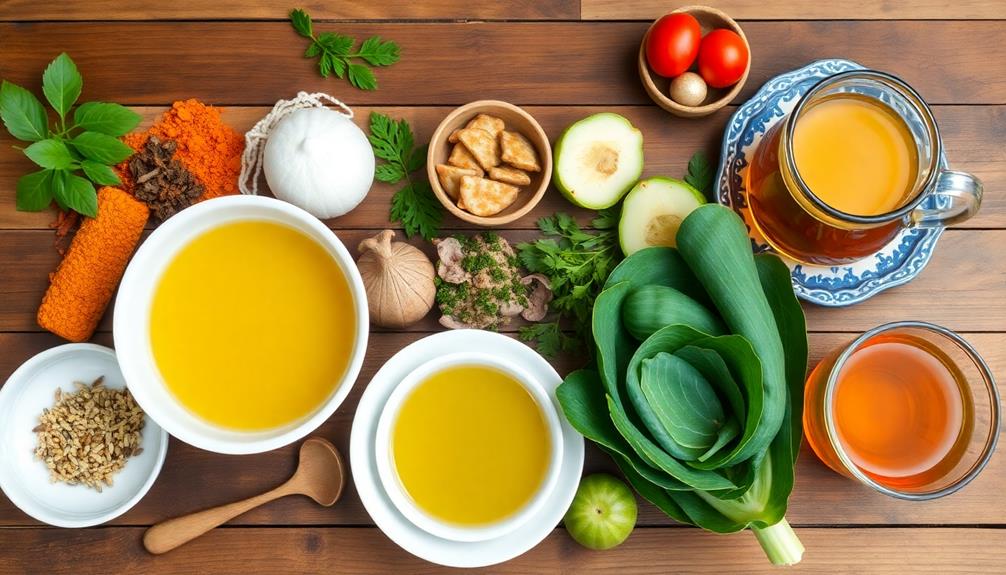
Different cultures offer unique perspectives on detox foods, shaped by their traditions and beliefs. For instance, Ayurveda promotes herbal treatments and spices to cleanse the body, while traditional Chinese medicine emphasizes foods like goji berries for liver support. In Japan, fermented foods enhance gut health, and Mediterranean diets focus on whole foods for detox benefits. Indigenous practices often incorporate natural plants in rituals. Modern detox trends can sometimes lean toward commercialization, often missing cultural depth. Each culture provides valuable insight into healthy approaches, and there's so much more to explore about these fascinating detox practices if you look closer.
Key Takeaways
- Ancient civilizations utilized fasting and herbal remedies, forming the foundation of modern detox practices emphasizing fresh, nutrient-rich foods.
- Ayurvedic practices in India and Chinese medicine employ specific herbs and foods to support detoxification and balance bodily energies.
- Indigenous cultures often incorporate spiritual rituals and natural plants in their detox processes, highlighting a holistic approach to cleansing.
- Nutritional science supports detoxification through hydration, fiber-rich foods, and superfoods that enhance the body's natural detox processes.
- Globalization has influenced detox trends, blending traditional practices with modern dietary choices, often leading to the commercialization of detox foods.
Historical Perspectives on Detox

Throughout history, various cultures have embraced detoxification as an essential practice for maintaining health. You'll find that ancient civilizations like Egypt, Greece, and China utilized fasting and herbal remedies to cleanse the body of impurities.
These early practices laid the groundwork for modern dietary practices centered on detoxification. For instance, the use of fresh, nutrient-rich ingredients, such as those found in Nettle and Potato Soup, reflects a commitment to health and wellness that resonates with detox principles.
In Ayurveda, detoxification plays a vital role, emphasizing the balance of energies and the removal of toxins known as "ama" through specific dietary practices and herbal treatments.
Fast forward to the early 20th century, and you'll notice the rise of detox diets in Western cultures. Influenced by health movements advocating natural foods, these diets aimed to promote holistic wellness.
Additionally, cultural traditions like Japan's seasonal eating highlight the importance of fresh, local foods, which support the body's natural detoxification processes throughout the year.
Today, while contemporary detox trends often draw from these historical practices, they've also transformed into commercialized diets and products. Unfortunately, many of these lack robust scientific validation for their efficacy.
Understanding these historical perspectives can offer valuable insights into the evolution of detoxification practices across cultures.
Traditional Detox Practices Worldwide

Traditional detox practices around the world reflect a deep understanding of the body's need for balance and purification. In India, Ayurvedic practices utilize a regimen called Panchakarma, where you can experience herbal treatments, oil massages, and dietary modifications aimed at cleansing toxins from your body.
Additionally, traditional Indian meals like Mushroom Masala can provide a vegetarian-friendly option that isn't only delicious but also supports the detox process through its rich blend of spices.
Meanwhile, Chinese medicine promotes specific food practices, like consuming chrysanthemum tea and goji berries, believed to enhance liver function and support detoxification.
In Native American cultures, purification rituals incorporate natural plants and herbs such as sage and sweetgrass, emphasizing both physical and spiritual detoxification.
The Mediterranean diet, rich in fruits, vegetables, and olive oil, provides antioxidants that help your body eliminate toxins while boosting liver health.
Japanese culture highlights the importance of fermented foods like miso and natto, which not only improve gut health but also facilitate detoxification through better digestion.
Each of these traditional practices showcases unique food practices that promote a holistic approach to detoxification, emphasizing the importance of natural ingredients in maintaining overall well-being.
Modern Interpretations of Detox Foods
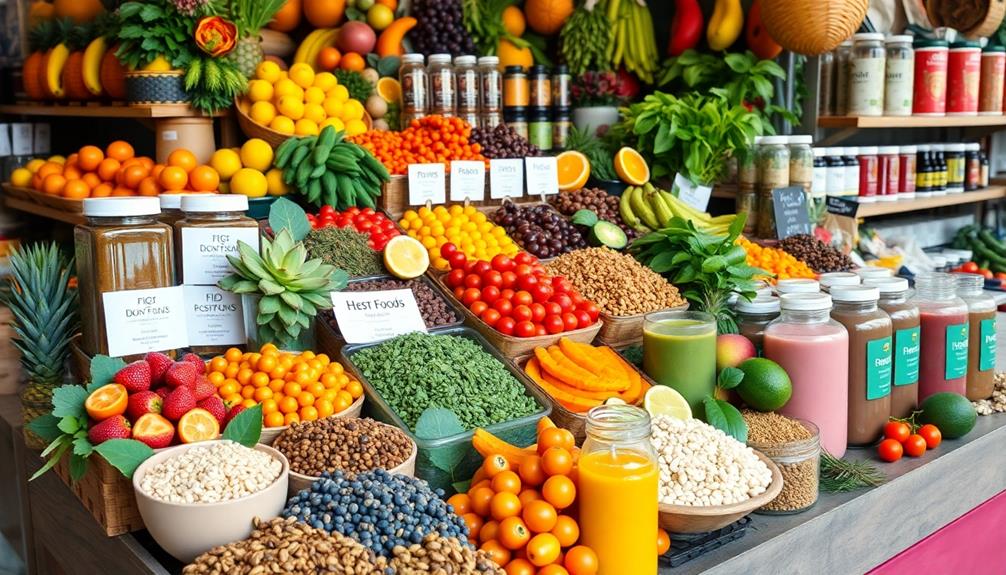
In today's health-conscious world, modern interpretations of detox foods focus on integrating nutrient-dense superfoods into your diet. You're likely to encounter recommendations that emphasize whole, organic options while steering clear of processed foods and unhealthy fats. This approach aims to enhance your body's natural detoxification processes and support overall well-being.
For instance, incorporating dishes like Red-Braised Pork Belly, which features slow-braised pork rich in flavor, can provide a satisfying balance when enjoyed in moderation.
Here are four key components of modern detox practices:
- Superfoods: Incorporate nutrient-rich foods like spirulina, chlorella, and kale, which are believed to aid in detoxification.
- Hydration: Prioritize water and herbal teas to help eliminate toxins and maintain bodily functions.
- Fruits and Vegetables: Fill your plate with a variety of fruits and veggies to support liver and kidney health.
- Elimination of Processed Foods: Cut back on processed foods to reduce your intake of unhealthy fats and additives.
While detox juices and supplements are gaining popularity, remember that their short-term results may not lead to sustainable health benefits.
Instead, focus on integrating these practices into your daily routine for lasting effects on your overall wellness.
Nutritional Science and Detoxification
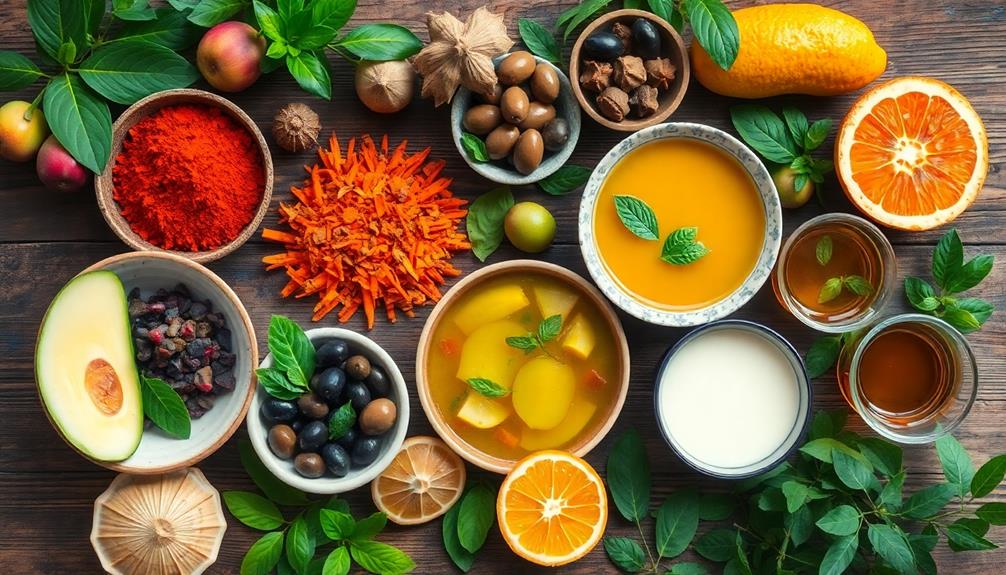
Detoxification isn't just a trendy buzzword; it's a fundamental process your body performs daily. Your body constantly works to eliminate toxins through organs like the liver, kidneys, and lymphatic system. To support this natural process, you can incorporate certain superfoods into your diet. These foods are packed with essential nutrients that enhance your body's ability to detoxify.
Here's a quick look at some superfoods and their detox benefits:
| Superfood | Detox Benefits |
|---|---|
| Spirulina | Rich in antioxidants, supports liver function |
| Kale | High in fiber, aids in digestion and toxin elimination |
| Berries | Packed with vitamins, help reduce inflammation |
Hydration is also key. Drinking plenty of clean water and herbal teas helps flush out toxins and maintains ideal kidney function. Plus, dietary fiber from fruits, vegetables, and whole grains promotes regular bowel movements, which is essential for excreting waste. By understanding the nutritional science behind detoxification, you can make informed choices that enhance your body's natural processes.
Cultural Beliefs Shaping Detox Choices
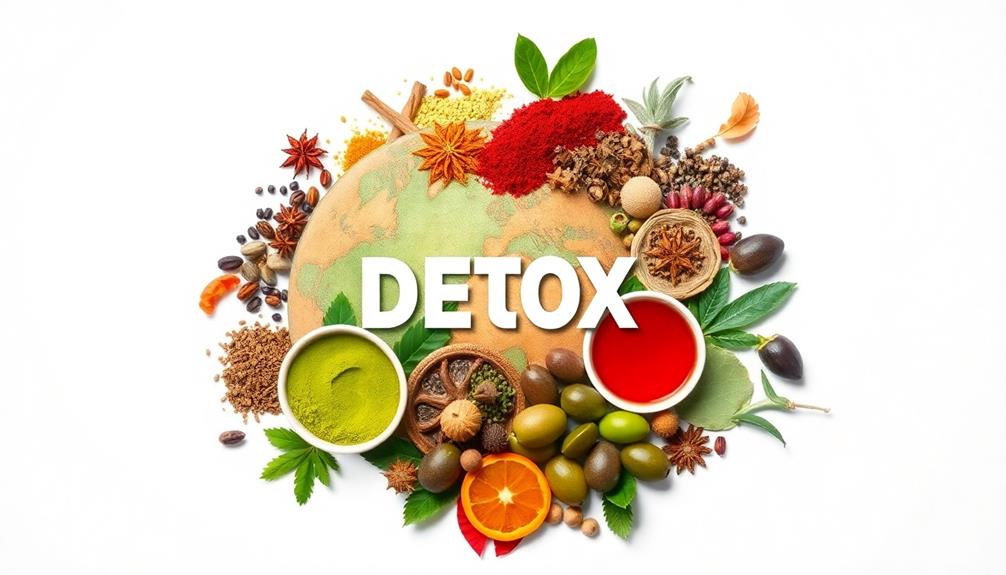
Cultural beliefs play a big role in how you choose detox foods.
While some traditions emphasize herbal teas and broths, others focus on superfoods like wild berries and roots that connect to local identities.
Understanding these practices can help you appreciate the rich tapestry of detoxification methods around the world.
Traditional Detox Practices
Many traditional detox practices reflect deep-rooted beliefs about health and wellness, showcasing how different cultures approach the idea of cleansing the body. You might find it fascinating how these practices often center around specific food consumption and natural remedies.
Here are some notable examples:
- Ayurvedic Practices: Emphasizing seasonal cleansing diets, these traditions utilize spices like turmeric and ginger to aid digestion and eliminate toxins.
- Japanese Methods: Incorporating fermented foods like miso and natto, these practices focus on probiotics that promote gut health and natural detoxification.
- Indigenous Rites: Fasting or consuming sacred plants and fruits often forms part of spiritual and physical cleansing rituals in many indigenous cultures.
- Mediterranean Diet: This approach emphasizes whole, organic foods, such as fruits, vegetables, and olive oil, believed to enhance the body's natural detoxification pathways.
Superfoods Across Cultures
Superfoods play a pivotal role in diverse culinary traditions, shaping how various cultures approach detox and wellness. In many regions, you'll find superfoods like spirulina and chlorella celebrated for their detoxification properties, often incorporated into daily diets for their health benefits.
Japanese cuisine emphasizes seasonal fruits and vegetables like seaweed and miso, which are believed to support the body's natural detoxification processes.
Latin American cultures turn to nutrient-rich foods such as amaranth and chia seeds, known for their high fiber content, to enhance digestion and promote effective detoxification.
Meanwhile, in India, Ayurvedic principles highlight spices like turmeric and ginger, regarded as essential for their anti-inflammatory and detox-supporting qualities, making them staples in cleansing diets.
African cultures also embrace superfoods like moringa and baobab, lauded for their nutrient density and antioxidant properties, integrating them into traditional meals for health enhancement and detoxification support.
Impact of Globalization on Detox Trends

Embracing globalization has transformed detox trends, making them more accessible and appealing to diverse cultures worldwide. You might notice that detox products are now readily available, but this shift comes with both benefits and challenges.
Here are some key impacts of globalization on detox trends:
- Widespread Access: Detox products are easier to find than ever, allowing individuals from various backgrounds to explore these health practices.
- Social Media Influence: Platforms like Instagram and TikTok have accelerated the popularity of detox diets, shaping dietary choices across different cultures.
- Conflict with Traditional Values: As cultures adopt Western dietary practices, processed detox foods often replace traditional food, undermining local culinary heritage.
- Commodification of Culture: Global marketing can dilute the significance of traditional foods, emphasizing quick fixes over sustainable practices that promote long-term health.
While globalization introduces you to novel detox approaches, it's essential to remember the value of traditional food practices.
Striking a balance between embracing new trends and honoring your cultural roots can lead to a healthier, more meaningful detox experience.
Detox Foods in Popular Diets
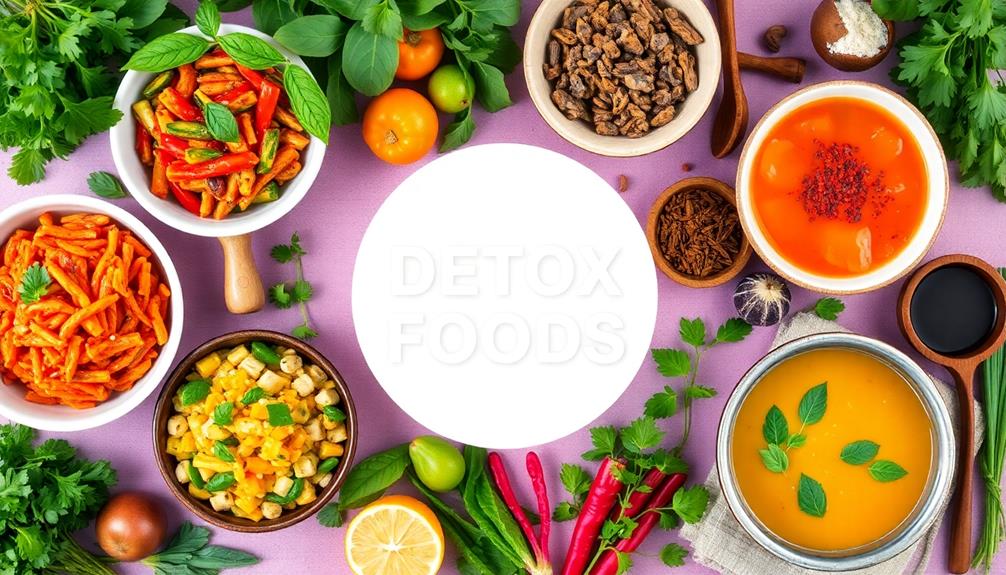
Detox foods play an essential role in popular diets, offering a range of options that promise to enhance your health and well-being. Many of these diets emphasize superfoods like kale, spirulina, and berries, which are packed with crucial nutrients that support your body's natural detoxification processes. You'll often find that these programs advocate for cutting out processed foods and allergens to help reduce toxin buildup.
Juice cleanses are another trendy option, where you consume only fruit and vegetable juices for a set period. Advocates claim this approach can reset your digestive system and promote weight loss. The ketogenic diet also incorporates detoxing elements, focusing on healthy fats and low-carbohydrate foods that can lower insulin levels and encourage fat burning.
Here's a quick overview of some popular detox foods and their associated eating patterns:
| Detox Foods | Eating Patterns |
|---|---|
| Kale | Superfood-focused meals |
| Fruit & Veg Juices | Juice cleanse regimes |
| Healthy Fats | Ketogenic meal plans |
Health Benefits Across Cultures

When you explore detox practices around the world, you'll find that traditional methods often focus on natural ingredients to enhance health.
In many cultures, incorporating nutrient-rich superfoods like ginger, spirulina, and nopal cactus is believed to boost energy and support digestion.
Understanding these diverse approaches can help you appreciate the holistic benefits of detoxification.
Traditional Detox Practices
Across various cultures, traditional detox practices offer unique insights into promoting health and well-being. These methods highlight the importance of detoxification through natural means, often utilizing the wisdom of generations past.
Here are four notable practices you might find beneficial:
- Ayurvedic Panchakarma: This regimen combines dietary changes, herbal treatments, and therapeutic massages to cleanse the body and restore balance.
- Japanese Seasonal Foods: Ingredients like daikon radish and pickled vegetables are emphasized for their digestive health benefits, aiding in toxin elimination.
- Native American Sweat Lodges: This practice uses steam and heat to promote sweating, believed to release impurities and enhance physical and spiritual health.
- Traditional Chinese Medicine Broths: Warm, cooked foods, especially broths and teas made from ginger and garlic, support digestion and enhance the body's detoxification capabilities.
These traditional practices reflect a deeper understanding of how food and natural therapies can contribute to overall health.
Nutrient-Rich Superfoods
Exploring traditional detox practices naturally leads to the importance of incorporating nutrient-rich superfoods into your diet. These foods aren't just trendy; they play a crucial role in supporting your body's detoxification processes.
For instance, in many cultures, spirulina and chlorella are celebrated for their high levels of vitamins and minerals that enhance detoxification.
Japanese cuisine emphasizes fermented foods like miso and natto, which are packed with probiotics that improve gut health and help eliminate toxins effectively.
Meanwhile, traditional Indian diets often feature turmeric, a powerful superfood known for its anti-inflammatory properties that support your body's natural detox pathways.
Berries, rich in antioxidants, are consumed worldwide for their ability to combat oxidative stress and promote liver health—an essential organ in detoxification.
Additionally, leafy greens like kale and spinach are staples in various diets, providing essential nutrients and fiber that facilitate digestive health and toxin removal.
Sustainable Approaches to Detoxing

How can you detox sustainably without resorting to extreme diets? The key lies in embracing whole, unprocessed foods that nourish your body and support its natural detoxification processes. You don't need quick fixes; instead, focus on long-term health through mindful eating.
Consider these sustainable approaches to detoxing:
- Incorporate Superfoods: Add nutrient-dense options like spirulina, chlorella, and kale to your meals. They enhance detoxification and promote well-being.
- Stay Hydrated: Drink plenty of water and herbal teas to help your body eliminate toxins effectively. Hydration is vital for a successful detox.
- Reduce Processed Foods: Cut down on foods high in unhealthy fats and additives. This shift not only supports detoxing but also helps improve your overall health.
- Cultivate a Positive Body Image: Focus on nourishing your body rather than temporary weight loss goals. A healthy relationship with food is essential for sustainable eating.
Frequently Asked Questions
How Are Food Choices Influenced by Culture?
Your food choices reflect your cultural background, shaping your preferences and beliefs. Traditions, values, and communal practices influence what you eat, guiding you toward certain ingredients, cooking methods, and dietary patterns that resonate with your identity.
How Do Culture and Ethnicity Play a Role in Dietary Intake?
Culture and ethnicity shape your dietary intake by influencing what foods you value, how you prepare them, and the communal practices around eating. These factors determine your perceptions of health and wellness in food choices.
What Are the Cultural Beliefs About Food?
You'll find that cultural beliefs about food shape your eating habits considerably. They influence what you consider healthy, how you prepare meals, and the rituals surrounding food, all reflecting your community's values and traditions.
What Are the Cultural Influences on the Mediterranean Diet?
Did you know that Mediterranean countries boast some of the world's longest life expectancies? You'll find cultural influences in communal meals, local ingredients, and traditional cooking methods, all promoting health and connection through food.
Conclusion
In exploring how different cultures approach detox foods, you've uncovered a rich tapestry of beliefs and practices. As the saying goes, "You are what you eat," highlighting the importance of making mindful choices. From ancient traditions to modern interpretations, understanding these diverse perspectives can enrich your own wellness journey. By appreciating cultural nuances and adapting sustainable practices, you can cultivate a balanced approach to detoxing that resonates with your unique lifestyle and values.
Lifestyle
The Science Behind the ‘Cooling’ Effect of Certain Spices
Amidst the fiery flavors of spices lies a fascinating cooling effect—discover how this phenomenon works and what it means for your palate.
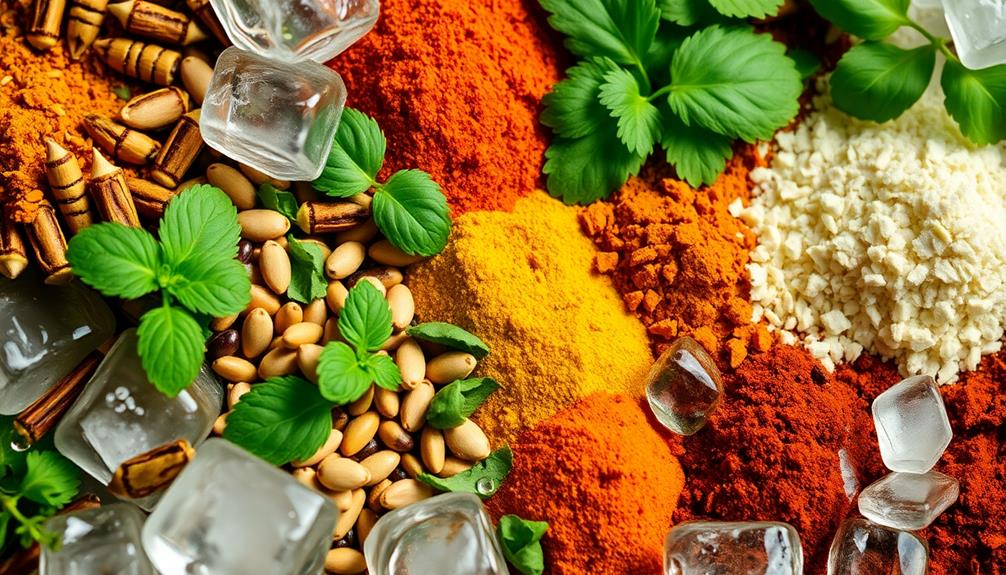
Certain spices, like chili peppers, trigger a unique 'cooling' effect due to capsaicin. When you consume spicy food, capsaicin binds to pain receptors, signaling your brain and creating a burning sensation that actually promotes sweating. This sweating helps your body cool down, especially in dry climates. Your body's increased blood flow and heart rate further assist in temperature regulation. Balancing spicy dishes with fresh herbs or dairy can enhance this effect and provide relief. If you're curious about how different cultures implement these techniques, you might find some surprising flavor combinations and cooking methods awaiting you.
Key Takeaways
- Capsaicin in spicy foods triggers sweating, which cools the body through evaporation, especially effective in dry environments.
- Fresh herbs like mint activate cool receptors, providing a refreshing contrast to spicy flavors.
- Dairy products, such as yogurt, bind to capsaicin, reducing heat and adding creaminess to dishes.
- Acidic elements like citrus juice enhance flavors while balancing the heat in spicy dishes.
- Individual tolerance to spiciness influences the thermoregulatory response and perceived cooling effect.
Understanding Capsaicin's Role

When you consume spicy peppers, capsaicin—the active compound—plays an essential role in your body's cooling response. This intriguing substance binds to pain receptors known as TrpV1 proteins, creating a sensation of heat that tricks your brain into thinking you're overheating. As a result, your body kicks into action, triggering several physiological responses.
Dishes like Cumin Lamb illustrate how the bold flavors of spices can enhance the experience of eating spicy foods while also contributing to this cooling effect. You might notice an increase in sweating and an elevated heart rate, which help regulate your body temperature. This cooling effect isn't just about feeling hot; it's your body's natural way of keeping cool.
Notably, the burning sensation can also stimulate the release of endorphins, leading to a temporary euphoric feeling alongside the cooling effects. Capsaicin's unique structure allows it to interact effectively with sensory neurons, simulating a state of overheating. This prompts mechanisms such as increased blood flow and sweating, further enhancing your body's ability to cool down.
Research shows that consuming spicy foods can even boost your metabolic rate, making the cooling effect more pronounced, especially in hot environments. So next time you enjoy a spicy dish, remember that capsaicin is working hard to help you stay cool.
The Physiology of Spicy Foods
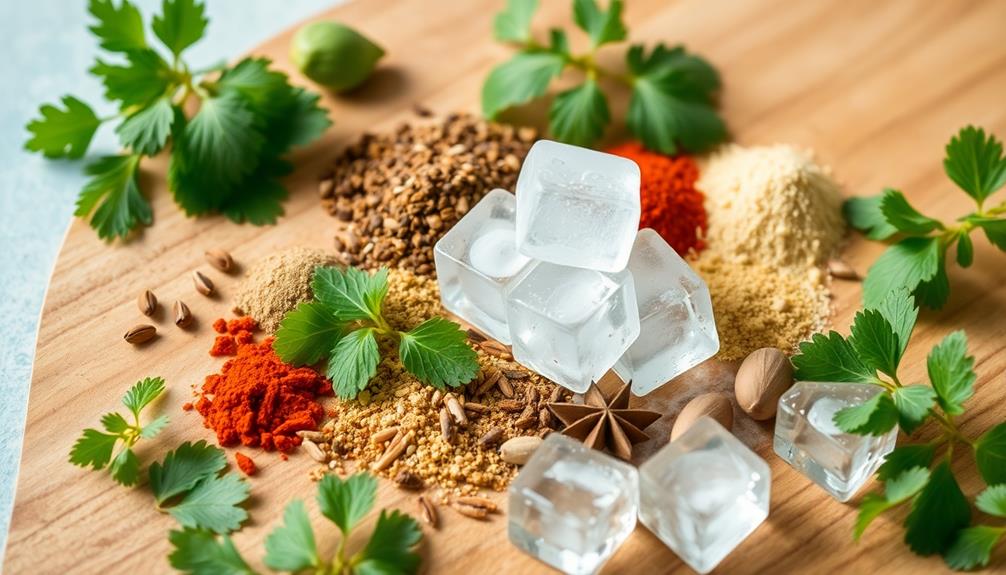
Spicy foods ignite a cascade of physiological responses in your body, primarily due to capsaicin's interaction with pain receptors. When you consume spicy food, capsaicin binds to the TrpV1 protein in sensory neurons, signaling a burning sensation. This reaction prompts your body to increase blood flow and metabolic activity as it tries to regulate body temperature.
Notably, many spicy dishes, like the Korean staple bibimbap which often features gochujang, showcase how spices can enhance both flavor and health benefits.
As you eat more spicy foods, you may notice you're sweating—this is your body's natural cooling mechanism at work. The evaporation of sweat helps lower your body temperature, providing relief from the heat sensation. Additionally, spicy foods can lead to increased mucus production in your respiratory system and dilation of blood vessels, further enhancing circulation.
Your individual tolerance to spiciness plays an essential role in how you experience these effects. If you're accustomed to spicy foods, you might notice a more pronounced thermoregulatory response, making the cooling effect even more effective.
Cultural Perspectives on Spiciness
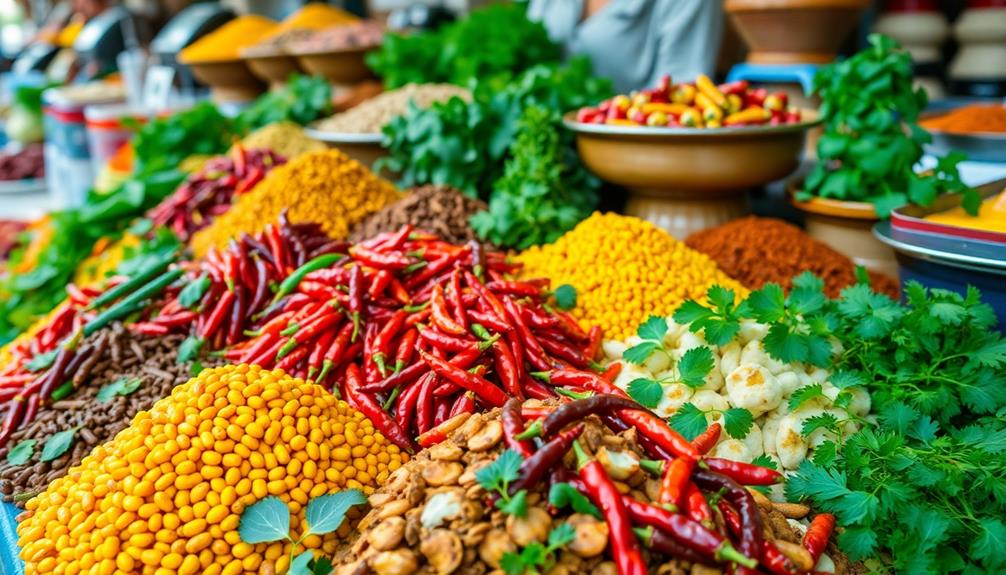
Food cultures around the world celebrate the use of spices, often making them a defining feature of culinary identity. In countries like Thailand, India, and Mexico, spicy foods are integral to their cuisines, showcasing the vibrant flavors of chiles and spices, such as those found in dishes like Chilaquiles and Cochinita Pibil.
These elements not only enhance taste but also create a sense of belonging and pride within communities. When you share a spicy dish during a family gathering or a festive occasion, you're partaking in a tradition that strengthens social bonds.
Many cultures introduce children to spicy flavors early on, embedding these tastes into their culinary preferences for life.
Interestingly, the global appetite for spicy foods is growing. More people are embracing adventurous eating, enthusiastic to challenge their taste buds with higher heat levels.
However, perceptions of spiciness can differ widely. While some consider it a mark of sophistication, others might find excessive heat off-putting, preferring milder flavors.
Ultimately, your relationship with spicy food is shaped by your cultural background and personal experiences, making every bite a unique reflection of your culinary journey.
Balancing Heat With Cooling Ingredients
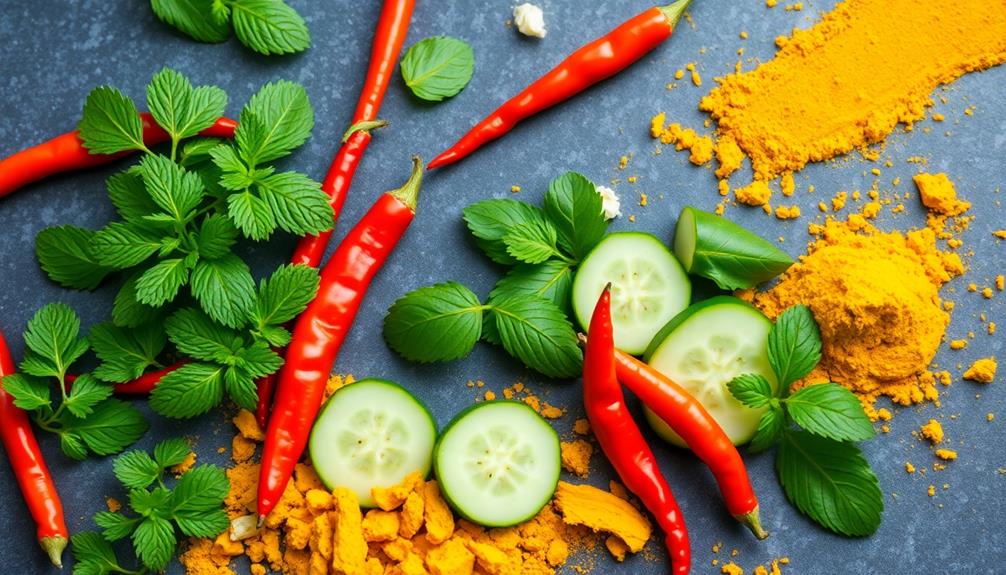
When you're cooking with heat, don't forget about the herbs that cool things down.
Pairing spicy ingredients with fresh herbs like mint or cilantro can transform your dish, balancing intense flavors and making each bite enjoyable.
Let's explore how these flavor pairing techniques can elevate your meals while keeping the heat in check.
Herbs That Cool
The invigorating essence of cooling herbs like mint and cilantro can transform a dish, balancing the heat of spicy ingredients with their vibrant flavors.
Mint contains menthol, which activates cool receptors in your body, giving you a revitalizing sensation without pain. This makes it an ideal companion for spicy foods, enhancing the overall experience. You might find that adding fresh mint to a spicy sauce can create a delightful contrast that makes each bite enjoyable.
Cilantro, often featured in tropical cuisines, not only elevates flavor but also helps neutralize the heat. By incorporating these herbs that cool into your meals, you create a harmonious balance that pleases your palate.
Additionally, you can pair these herbs with dairy-based ingredients, like yogurt or sour cream, which contain a protein called casein. This protein binds to capsaicin, the compound responsible for spiciness, effectively dulling its effects.
Flavor Pairing Techniques
Balancing heat with cooling ingredients can elevate your culinary creations to new heights. When you enjoy spicy foods, you might find that combining them with cooling herbs like mint or cilantro creates a harmonious flavor profile. This technique effectively mitigates the intensity of the heat while enhancing your overall dining experience.
Take a cue from traditional dishes such as Vietnamese spicy noodle soups, where chile paste is paired with fresh herbs to cool the palate. Similarly, Ethiopian cuisine utilizes berbere spice blends alongside yogurt, tempering the heat without sacrificing flavor. Yogurt-based sauces like raita in Indian cuisine also serve as a perfect complement, adding a creamy texture that balances out the spices.
Don't forget about cooking methods! Roasting or grilling spicy ingredients can amplify their flavor, and when you incorporate cooling elements, you enhance both taste and texture.
By mastering these flavor pairing techniques, you can create dishes that not only satisfy your craving for heat but also provide a revitalizing contrast, making each bite a delightful experience.
Cooking Techniques for Spicy Dishes

When you're cooking spicy dishes, balancing heat with cooling ingredients is key to creating a delightful meal.
You can enhance flavor by incorporating fresh herbs like mint, which not only complement the spices but also add a revitalizing touch.
Balancing Heat and Coolness
Spicy dishes can be a culinary adventure, but achieving the right balance between heat and coolness is key to a satisfying experience. By incorporating cooling herbs and techniques, you can create a harmonious blend that tantalizes your palate.
| Cooking Technique | Benefits | Examples |
|---|---|---|
| Roasting | Intensifies flavors, reduces moisture | Spicy roasted chiles |
| Adding Dairy | Cools the dish, adds creaminess | Yogurt sauces, sour cream |
| Adjusting Consistency | Revitalizes heat with citrus and herbs | Citrus pesto, herb-infused sauces |
Using spicy ingredients alongside cooling herbs like mint or cilantro can elevate your dishes. Techniques like roasting intensify flavors without overwhelming heat, while incorporating yogurt can create a delightful creamy texture. Adjusting the consistency of sauces with citrus juices brings a rejuvenating counterpoint, making each bite enjoyable.
For example, dishes like Calabrian pasta utilize fresh herbs to balance spice. By mastering these techniques, you'll guarantee that your spicy creations are both thrilling and palatable, allowing everyone to savor the adventure without the burn!
Enhancing Flavor With Herbs
Incorporating herbs into your spicy dishes not only enhances flavor but also creates a more enjoyable dining experience. When you combine spicy chiles with cooling herbs like mint or cilantro, you achieve a balanced flavor profile that tempers the heat.
Techniques such as roasting spices can intensify their flavor without overwhelming your dish, resulting in a complex taste that complements spicy food really well.
To add cooling elements, consider incorporating yogurt-based sauces. These not only cool the palate but also provide a creamy texture that pairs beautifully with heat.
Don't forget to chop fresh herbs and add them at the end of cooking; this preserves their vibrant flavor and aromatic qualities, offering a revitalizing contrast to the spices.
Using acid, such as citrus juice or vinegar, can also brighten the overall flavor of your dish. This acidity helps balance the heat, making your spicy food even more enjoyable.
Natural Remedies for Spice Discomfort
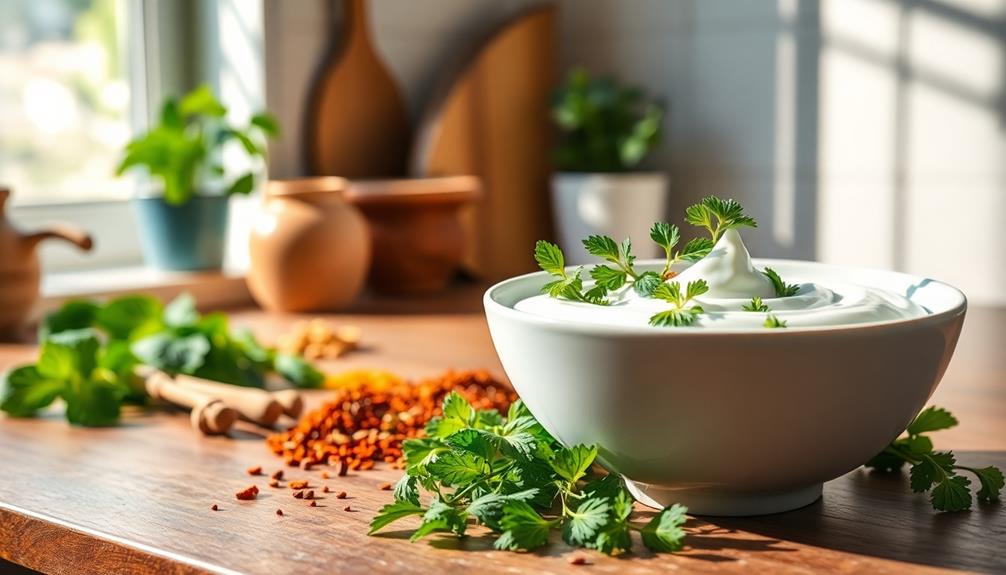
If you've ever felt the fiery sting of spicy foods, you're not alone—many people experience discomfort from capsaicin.
Fortunately, there are natural remedies to ease the burning sensation and help with digestive issues. Here are some effective options:
- Milk: The most effective remedy, milk contains casein, which binds to capsaicin and reduces its impact on your mouth and throat.
- Sugar Water: A 10% sugar solution can neutralize spiciness and provide quick relief from discomfort.
- Dairy Products: Foods like yogurt and ice cream can be soothing due to their fat content, which helps dissolve capsaicin.
It's vital to avoid drinking water after consuming spicy foods. Water may spread capsaicin around your mouth, intensifying the burning sensation instead of alleviating it.
While beer can help dissolve capsaicin, it's generally less effective than milk.
Whenever you indulge in spicy dishes, keep these remedies in mind to guarantee you're prepared for any spice discomfort that might arise.
With these tips, you'll be able to enjoy your favorite spicy meals without fear!
Spicy Foods and Body Temperature Regulation
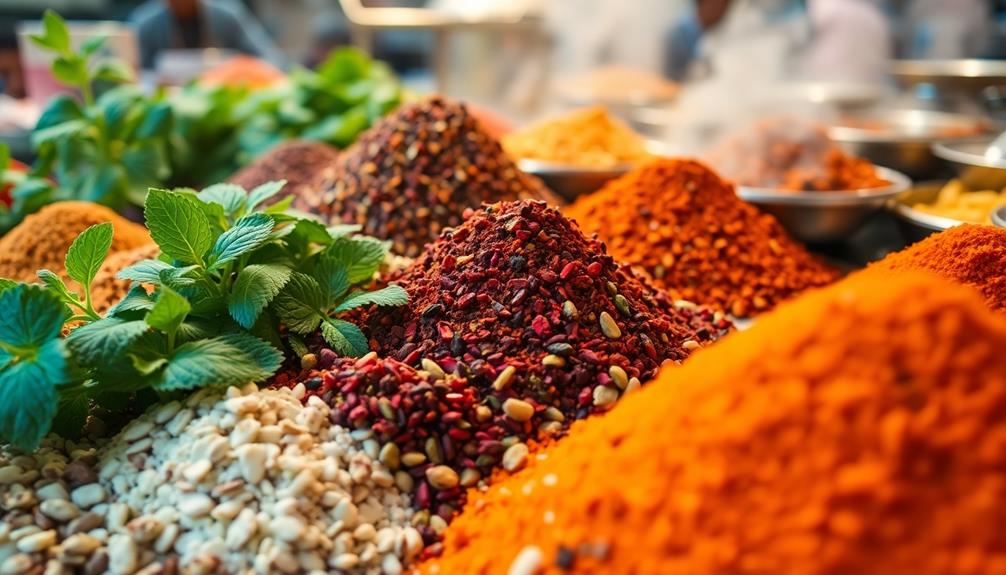
Consuming spicy foods can surprisingly play a role in how your body regulates temperature. When you eat spicy foods, the active compound capsaicin activates pain receptors in your mouth, signaling your body to respond. This leads to increased blood flow and sweating, which acts as a natural cooling mechanism.
As sweat evaporates from your skin, it helps dissipate heat, effectively aiding in body temperature regulation. The cooling effect of spicy foods can be more pronounced in dry environments, where sweat evaporates efficiently. In humid conditions, however, this process can be hindered, making the cooling effect less noticeable.
Curiously, drinking warm liquids can enhance this reaction even further. Hot beverages can promote sweating, which helps you cool down more effectively than cold drinks.
It's important to note that individual tolerance to spiciness varies. While some people may find the cooling effect invigorating, others might feel discomfort or increased heat, which can influence how well spicy foods assist in body temperature regulation.
Exploring Global Spicy Cuisines
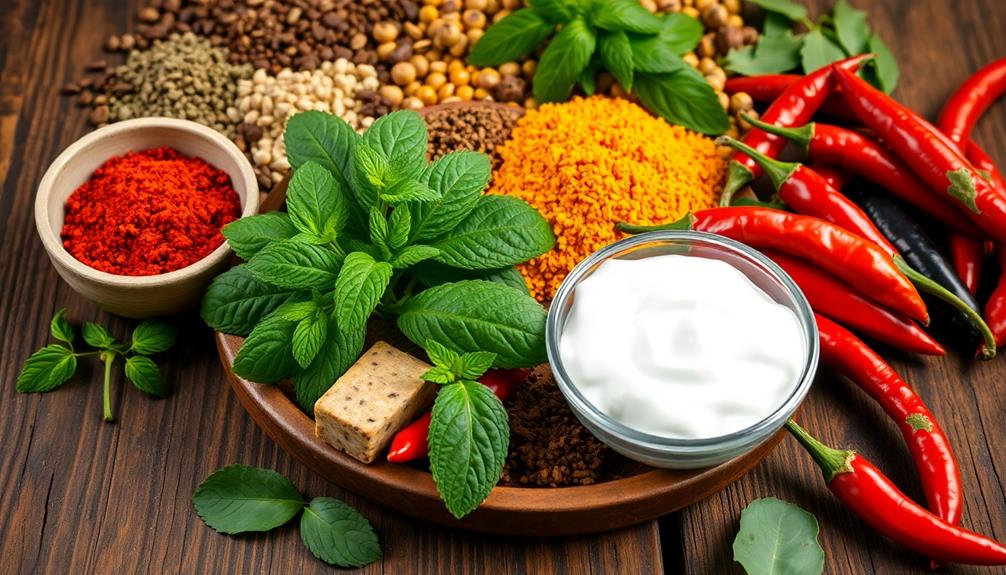
Spicy cuisines from around the world offer a vibrant blend of flavors that not only tantalize your taste buds but also provide unique cooling effects. These cuisines achieve a balance between heat and freshness, often inducing sweating, which helps cool your body.
- Thai and Vietnamese: Spicy dishes are complemented by fresh herbs, enhancing flavor while promoting a cooling sensation.
- Indian Cuisine: A combination of chili peppers and cooling ingredients like yogurt stimulates your palate while offering relief from the heat.
- Mexican Delights: Jalapeños and habaneros add heat that enhances the overall sensory experience of the food.
The Caribbean showcases scotch bonnet peppers, delivering intense heat balanced by coconut and fresh citrus, creating harmony on your plate.
Meanwhile, Ethiopian cuisine employs berbere spice blends that add depth, often served with injera, a fermented flatbread that cools the spice.
Each culture embraces the art of balancing spicy dishes with cooling elements, making every bite an exhilarating experience.
Next time you immerse yourself in these global flavors, enjoy the sensation of heat while appreciating how they contribute to your body's natural cooling process.
Frequently Asked Questions
Which Spices Have a Cooling Effect?
You'll find that spices like mint, cilantro, and fennel offer a cooling effect. These ingredients balance out spicy dishes, enhancing flavor while providing a revitalizing sensation that brightens your meals and tempers the heat.
Why Does Spicy Food Cool You Down?
When you eat spicy food, it triggers your body's heat receptors. This reaction increases sweating, which cools you down as the moisture evaporates. It's a natural response that can surprisingly be more effective than cold drinks.
What Is the Science Behind Spice Tolerance?
Understanding spice tolerance involves recognizing your genetic makeup and exposure to spicy foods. Regular consumption can enhance your tolerance as your body adapts, desensitizing pain receptors and altering your perception of spiciness over time.
What Is the Science Behind Spices?
Spices are like magic potions, transforming mundane dishes into culinary masterpieces. They boost flavors and enhance aromas, while also offering health benefits. You'll discover their power in every meal, igniting your taste buds like fireworks.
Conclusion
In the vibrant tapestry of culinary experiences, spices serve as both fire and ice. Just as a flame can warm your heart, a cool breeze can refresh your spirit. Embracing the balance between heat and soothing ingredients lets you dance with flavors, igniting your palate while keeping you grounded. So, the next time you savor a spicy dish, remember: it's not just about the burn; it's about finding harmony in the symphony of tastes that elevate your dining experience.
Lifestyle
Why Some Foods Taste Better When Eaten at Specific Altitudes
You might be surprised to learn how altitude alters your taste perception and why chefs adapt meals to enhance your dining experience.

Foods taste different at specific altitudes primarily because your taste perception changes. At high altitudes, lower oxygen levels and reduced atmospheric pressure can decrease your ability to taste, leading to about a 30% drop in flavor sensitivity. Sweet and salty flavors are hit the hardest, making meals less enjoyable. To compensate, chefs often enhance dishes with increased salt and sugar, especially in airline meals. Additionally, your familiarity with high altitude can improve your taste experience. Want to discover more about how altitude affects flavor and how chefs adapt meals for your enjoyment?
Key Takeaways
- Taste perception decreases at high altitudes, making certain foods with enhanced flavors more enjoyable.
- Sweet and salty flavors are less effective at altitude, while umami and sour flavors remain stable.
- Increased salt and sugar in meals can compensate for diminished taste sensitivity at high altitudes.
- Familiarity with altitude can enhance taste experiences, making some foods more appealing.
- Innovative culinary adaptations, such as collaborations with chefs, improve in-flight dining flavors.
Effects of Altitude on Taste

As you ascend to higher altitudes, you may notice that your sense of taste takes a hit. Research shows that at high altitudes, your taste perception can decrease by about 30%. Changes in atmospheric pressure and reduced oxygen levels play a big role in this decline. Sweet and salty flavors often suffer the most, leaving you with a less satisfying meal.
However, sour tastes tend to remain stable, while bitter flavors may even intensify. Curiously, foods with rich umami flavors, like ankimo (monkfish liver pâté), can provide a more enjoyable experience at high altitudes due to their depth of taste.
The dry air at high altitudes further complicates things, as it diminishes your sense of smell, which accounts for roughly 80% of your taste experience. This combination can really affect how you enjoy food. For example, coffee aromas and tomato juice flavors are significantly altered in high-altitude environments, making them less appealing.
Remarkably, the more time you spend at high altitudes, the more your taste perception can adapt. Familiarity with these conditions can enhance your overall taste experience, allowing you to enjoy food in ways you mightn't have expected.
Understanding these effects can help you choose meals that suit your palate when you find yourself at great heights.
Airline Menu Adaptations

Airline menus are carefully crafted to enhance your dining experience at high altitudes, where taste perception diminishes considerably. Traditional dishes like Red-Braised Pork Belly are often adapted to retain their rich flavors in the air.
Airline chefs, like those for British Airways, account for these effects by adjusting their recipes. They often increase salt and sugar to boost flavors while keeping hydration in mind. Studies show that your sense of taste drops by about 30% during flights, which is why umami flavors become vital. This has led airlines to incorporate umami-rich ingredients to elevate meal options.
JetBlue collaborates with restaurant Saxon+Parole to create dishes that emphasize acidity, heat, and umami, ensuring that your in-flight meals remain flavorful.
British Airways has also recognized the need for specialized meals with enhanced flavor profiles. They focus on ingredients that cater to your taste buds at high altitudes, making your experience more enjoyable.
Continuous research into how altitude impacts taste perception motivates these culinary strategies, allowing airlines to refine their menus. By understanding the science behind your dining experience, airlines aim to enhance passenger satisfaction during flights, ensuring you savor every bite, even at cruising altitude.
Innovative Culinary Collaborations

Innovative culinary collaborations are transforming in-flight dining by addressing the unique challenges posed by high altitudes. Airlines like JetBlue and British Airways are teaming up with celebrated chefs to enhance your dining experience.
For example, JetBlue partners with Saxon+Parole, focusing on balancing acidity, heat, and umami flavors to cater to your diminished sense of taste at high elevations. This approach is similar to how Brazilian dishes like Caldeirada utilize rich flavors and diverse ingredients to create a satisfying experience.
Chef Brad Farmerie creatively uses ingredients like chili marshmallows in carrot and ginger soup to keep flavors vibrant without relying on excessive salt.
British Airways collaborates with Heston Blumenthal to explore ingredient perception, ensuring that the food you enjoy in the sky remains flavorful despite altitude's effects.
Lufthansa's partnership with the Fraunhofer Institute brings a scientific approach to identifying ideal food pairings, enriching the flavor profiles of meals served during flights.
These innovative culinary approaches are essential for developing meals that remain enjoyable for you at high altitudes. By emphasizing umami flavors and carefully selecting spices, airlines are reshaping your in-flight dining experience, making it more satisfying and memorable.
As these collaborations grow, your taste buds will thank you for the elevated dining experiences.
Specialized Beverage Offerings

How can specialized beverages elevate your in-flight experience? Airlines are now focusing on crafting drinks that enhance your enjoyment of food at high altitudes.
For instance, British Airways teamed up with Brewdog to create Speedbird 100 beer, specifically brewed to boost flavor perception while you're soaring through the skies. Similarly, Cathay Pacific offers a unique beer, designed with special ingredients that perform better in the cabin environment.
Wines from high-altitude regions also stand out, as they often maintain their flavor integrity during flights, enhancing your overall dining experience.
You'll find that the taste of food is greatly influenced by your sense of smell, which can be diminished in the cabin. That's why airlines are continuously adapting their beverage selections, ensuring you have options that are appealing and enjoyable at cruising altitudes.
While champagne is a classic choice, it tends to lose its fizz quickly due to cabin pressure, affecting the overall drinking experience.
Choosing specialized beverages can make a significant difference, allowing you to savor every bite and sip, ultimately transforming your journey into a delightful culinary adventure.
Challenges in Flavor Enhancement
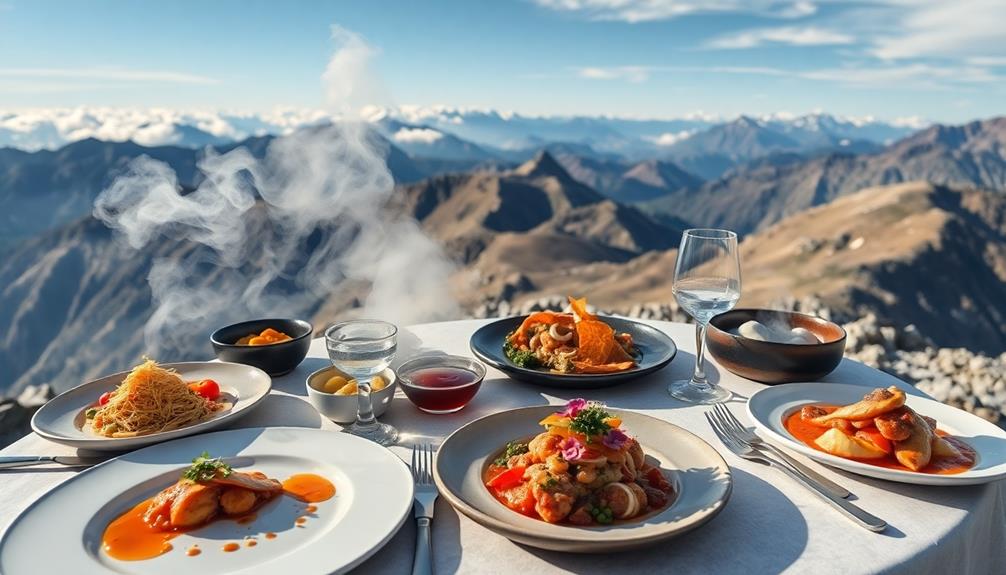
Steering through the challenges of flavor enhancement at high altitudes requires a thoughtful approach from culinary teams. Airlines, like British Airways, face the difficult task of making meals taste different while considering passenger hydration.
At high altitudes, increased salt and sugar can lead to dehydration, forcing chefs to balance flavor without compromising wellness.
Unfortunately, there aren't any formal recipes designed specifically for in-flight meals, which complicates the process. Culinary teams must also cater to a variety of dietary restrictions and preferences, making it even tougher to create universally appealing menus.
The diminished taste sensitivity you experience at altitude means that typical flavor profiles may not register as intended. This calls for innovative menu planning strategies that enhance flavor without overwhelming the palate.
Continuous research is essential to understand how altitude impacts flavor perception, providing the necessary insights to improve your in-flight dining experience.
Ultimately, the challenge lies in crafting meals that remain enjoyable and memorable, ensuring that each bite resonates even when you're miles above the ground.
Frequently Asked Questions
Why Does Food Taste Different at Different Altitudes?
Food tastes different at various altitudes because changes in atmospheric pressure affect your taste buds and sense of smell. You might find certain flavors less intense, while others, like bitterness, can become more pronounced.
Does Food Cook Differently at High Altitude?
Yes, food cooks differently at high altitudes. You'll notice longer cooking times and adjustments needed for recipes. Lower boiling temperatures affect textures, and you might need to modify ingredients to achieve the desired results.
What Foods Are Good to Eat at High Altitude?
When you're at high altitude, opt for hydrating foods like soups and stews. Nutrient-dense snacks, such as trail mix and energy bars, keep your energy up. Enjoy fruits for their enhanced sweetness; they'll taste amazing!
Why Does Food Taste Different in the Sky?
When you eat in the sky, lower pressure and humidity affect your taste buds. You'll notice flavors shift; sweet and salty might fade, while umami could pop, altering your overall dining experience during flights.
Conclusion
To wrap it up, eating at higher altitudes transforms flavors in ways you wouldn't believe! The reduced pressure and humidity can dull your taste buds, making some foods taste bland. Airlines have adapted their menus to combat this, collaborating with chefs to enhance flavors. Plus, specialized beverages can elevate your experience even more. So, next time you're soaring through the skies, remember that altitude can turn your meal into a culinary adventure that's nothing short of extraordinary!
-

 Vetted6 months ago
Vetted6 months ago14 Best Personalized Father's Day Gifts for Your Husband – Show Him You Care
-

 Alfresco5 months ago
Alfresco5 months agoAlfresco Stacker Doors: Seamless Indoor-Outdoor Living!
-

 Vetted6 months ago
Vetted6 months ago15 Best EMS Foot Massagers for Neuropathy to Soothe Your Feet
-

 Craft and Textiles7 months ago
Craft and Textiles7 months ago15 Best Places to Buy Appliances for Your Home – Top Retailers Reviewed
-

 Vetted5 months ago
Vetted5 months agoBattle Born Batteries Review: Reliable Power Solution
-

 Vetted5 months ago
Vetted5 months agoD-Link Switch Review: Lite Layer 3 Managed Networking
-

 Tableware and Dining Accessories7 months ago
Tableware and Dining Accessories7 months agoWhat Is the Meaning of the Word Tableware
-

 Tableware and Dining Accessories7 months ago
Tableware and Dining Accessories7 months agoWhat Is the Hindi Meaning of Tableware





























